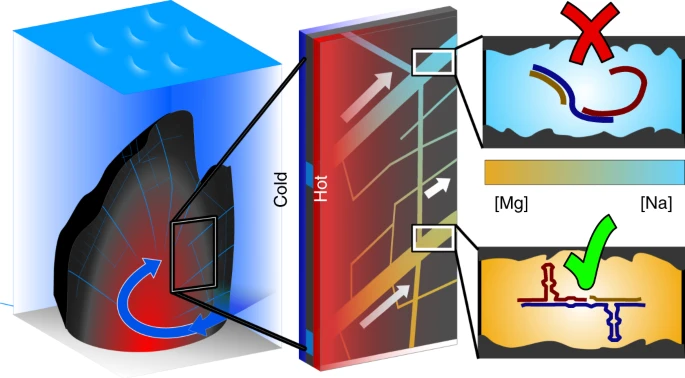Heat flows in rock cracks naturally optimize salt compositions for ribozymes
T. Matreux et.al. 2021 Nat. Chem. https://doi.org/10.1038/s41557-021-00772-5
26.08.2021
T. Matreux, K. LeVay, A. Schmid, P. Aikkila, L. Belohlavek, A. Z. Çalışkanoğlu, E. Salibi, A. Kühnlein, C. Springsklee, B. Scheu, D. B. Dingwell, D. Braun, H. Mutschler and C. B. Mast
Nat. Chem. https://doi.org/10.1038/s41557-021-00772-5
Abstract
Catalytic nucleic acids, such as ribozymes, are central to a variety of  origin-of-life scenarios. Typically, they require elevated magnesium concentrations for folding and activity, but their function can be inhibited by high concentrations of monovalent salts. Here we show that geologically plausible high-sodium, low-magnesium solutions derived from leaching basalt (rock and remelted glass) inhibit ribozyme catalysis, but that this activity can be rescued by selective magnesium up-concentration by heat flow across rock fissures. In contrast to up-concentration by dehydration or freezing, this system is so far from equilibrium that it can actively alter the Mg:Na salt ratio to an extent that enables key ribozyme activities, such as self-replication and RNA extension, in otherwise challenging solution conditions. The principle demonstrated here is applicable to a broad range of salt concentrations and compositions, and, as such, highly relevant to various origin-of-life scenarios.
origin-of-life scenarios. Typically, they require elevated magnesium concentrations for folding and activity, but their function can be inhibited by high concentrations of monovalent salts. Here we show that geologically plausible high-sodium, low-magnesium solutions derived from leaching basalt (rock and remelted glass) inhibit ribozyme catalysis, but that this activity can be rescued by selective magnesium up-concentration by heat flow across rock fissures. In contrast to up-concentration by dehydration or freezing, this system is so far from equilibrium that it can actively alter the Mg:Na salt ratio to an extent that enables key ribozyme activities, such as self-replication and RNA extension, in otherwise challenging solution conditions. The principle demonstrated here is applicable to a broad range of salt concentrations and compositions, and, as such, highly relevant to various origin-of-life scenarios.

